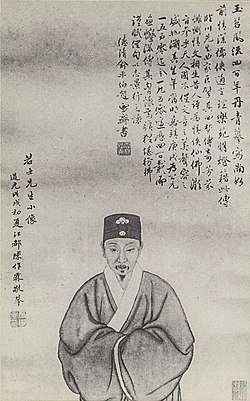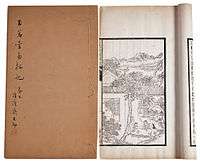Tang Xianzu
Tang Xianzu (traditional Chinese: 湯顯祖; simplified Chinese: 汤显祖; September 24, 1550 – July 29, 1616), courtesy name Yireng (義仍), was a Chinese playwright of the Ming Dynasty.

| Tang Xianzu | |||||||||||||||||||||||
|---|---|---|---|---|---|---|---|---|---|---|---|---|---|---|---|---|---|---|---|---|---|---|---|
| Traditional Chinese | 湯顯祖 | ||||||||||||||||||||||
| Simplified Chinese | 汤显祖 | ||||||||||||||||||||||
| |||||||||||||||||||||||
Biography
Tang was a native of Linchuan, Jiangxi and his career as an official consisted principally of low-level positions. He successfully participated in the Provincial examinations (juren) at the age of 21 and at the imperial examinations (jinshi) at the age of 34. He held official positions in Nanjing, Zhejiang province, Guangdong province etc. He retired in 1598 and returned to his hometown where he focused on writing. Tang died in 1616, the same year as famed English playwright William Shakespeare.[1]
His major plays are collectively called the Four Dreams, because of the decisive role dreams play in the plot of each one. All of them are still performed (in scenes, or in adapted full versions) on the Chinese Kun opera (kunqu) stage. Generally considered his masterpiece, the Mudan Ting (The Peony Pavilion) has been translated into English several times.
A translation of his complete dramatic works in English was published in China in 2014 and in London in 2018.
Legacy
A few Ming and Qing playwrights followed Tang's writing style and called themselves the Yumintang or Linchuan school.[2]
Works

- The Purple Flute (Chinese: 紫簫記; pinyin: Zǐxiāo Jì)
- The Purple Hairpin (Chinese: 紫釵記; pinyin: Zǐchāi Jì)
- See The Purple Hairpin (1957) 紫釵記 (粵劇) by Tang Ti-sheng
- The Peony Pavilion (Chinese: 牡丹亭; pinyin: Mǔdān Tíng)
- Record of Handan (Chinese: 邯鄲記; pinyin: Hándān Jì)
- Record of Southern Bough (Chinese: 南柯記; pinyin: Nánkē Jì)
Works available in English
- The Peony Pavilion (trans. Cyril Birch). Bloomington: Indiana University Press, 1980.
- The Peony Pavilion (trans. Wang Rongpei). Changsha: Hunan People's Press, 2000.
- A Dream Under the Southern Bough (trans. Zhang Guangqian). Beijing: Foreign Languages Press, 2003. ISBN 7-119-03270-4.
- The Handan Dream (trans. Wang Rongpei). Beijing: Foreign Languages Press, 2003
- The Complete Dramatic Works of Tang Xianzu (trans. Wang Rongpei & Zhang Ling) Bloomsbury: London, 2018. ISBN 9781912392025
Studies available in English
- Peony Pavilion Onstage : Four Centuries in the Career of a Chinese Drama (Catherine Swatek). Ann Arbor, MI: University of Michigan Center for Chinese, 2003.
- Tan, Tian Yuan and Paolo Santangelo. Passion, Romance, and Qing: The World of Emotions and States of Mind in Peony Pavilion. 3 Volumes. Leiden: Brill, 2014.
References
- Tian Yuan Tan, Paul Edmondson, Shih-pe Wang. 1616: Shakespeare and Tang Xianzu's China.CS1 maint: uses authors parameter (link)
- Dillon, Michael, ed. (1998). China: A Cultural and Historical Dictionary. London: Curzon Press. p. 312. ISBN 0-7007-0439-6.
- Xu, Shuofang, "Tang Xianzu". Encyclopedia of China (Music and Dance Edition), 1st ed.
Further reading
- Owen, Stephen, "Tang Xian-zu, Peony Pavilion: Selected Acts," in Stephen Owen, ed. An Anthology of Chinese Literature: Beginnings to 1911. New York: W. W. Norton, 1997. p. 880-906 (Archive).
External links
| Wikiquote has quotations related to: Tang Xianzu |
- Tang Xianzu on IMDb
- Tang Xianzu at the Hong Kong Movie DataBase